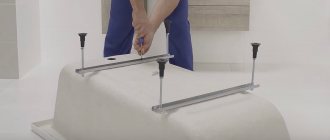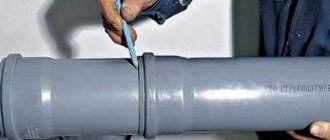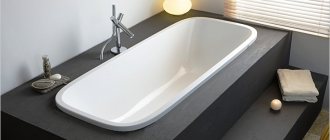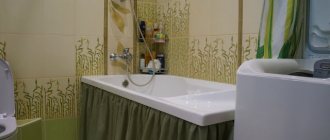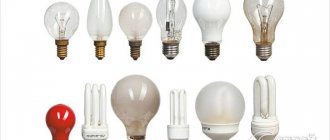Due to the fact that electrical appliances in the bathroom are constantly exposed to high humidity, the bathroom is considered one of the most dangerous places in the apartment from a safety point of view. Any electrical device can cause current leakage.
And if someone touches a live object, the consequences can be disastrous. Grounding a bathtub in an apartment is a simple procedure, but it can save a person’s life and health. It is this question that we will consider in our article. Let us examine in detail the reasons why grounding is necessary.
We will also provide detailed instructions on how to ground your bathtub yourself, supplementing the material with visual photos and video recommendations.
Theory
Many electronic household appliances these days have small metal grooves designed for grounding. This term refers to a special protection that takes electric current when it appears on the body of an object and leads it to the ground.
Everyone in their life has experienced mild electric shocks when touching electrical appliances. Quite often this can happen if you touch a computer, washing machine or heating tank. In the latter case, this occurs due to the formation of a hole in the heating element, which causes electricity to pass through the water.
Often this happens because the electrical wiring in our homes was not installed properly. If there are grounding devices, this problem will not cause inconvenience.
Installation of PMC
A PMC or potential equalization box will help simplify the process of grounding other household appliances. This is a plastic rectangular container with a zero busbar made of brass (or copper). The bus is located inside, with clamps-terminals placed on it.
The next step is to lay a single-core copper cable with a cross-section of at least six square millimeters in the cable duct along the baseboards. Start the cable path from the electrical panel and end near the control center. One end of the wire is stripped and secured to the zero bus with two washers coated with a zinc layer to the bolt. The second end of the same cable is also cleared of insulation and attached to the PCU on the zero bus, in a threaded clamp with the largest hole.
It is important not to confuse the current-carrying wires and the grounding conductor; the latter is wrapped with electrical tape or other yellow or green beacons.
Is an acrylic bathtub grounded?
Nowadays, acrylic bathtubs, which are lightweight and affordable, are especially popular.
Although this is a polymer that is dielectric (i.e. does not conduct current), such a bath still needs to be grounded for the following reasons
:
- casting and extrusion are two methods of producing acrylic bathtubs. Polymer produced by extrusion does not retain its shape well. It is the bowls made in this way that must be installed in a steel frame, which must be grounded;
- The acrylic bathtub is also grounded in order to remove static voltage. If the bowl is large, then this must be done, as this can lead to the bathtub accumulating a strong electrical charge.
Video on the topic
Protective grounding of a bathtub in an apartment is done for many reasons, the main one of which is increased humidity in the room and the associated risk of current leakage to the ground. This is explained by the fact that water poured into a bathtub is a conductor of electricity, and the bathtub itself, one way or another, is in contact with the ground.
People unfamiliar with the basics of electricity, when discussing whether it is necessary to ground a bathtub, reason as follows. “Why ground the bathtub,” they say, if it is isolated from the floor screed by a layer of ceramic tiles?
But at the same time, many people forget that its metal body is still connected to the ground through a system of water and sewer pipes.
Because of this, the touch of a washing person to a faulty electrical appliance (an electric razor wire with broken insulation, for example) can cause dangerous electric shock.
Therefore, making grounding in the bathroom is a primary task to protect the user from strong electric shock.
Let's add to this that reliable grounding in the bathroom has a threefold function:
- firstly, when a dangerous leak appears, it triggers a protective device (RCD), which instantly de-energizes the room;
- secondly, if due to low currents the RCD did not work (or turned out to be faulty), then if there is grounding, the voltage at the point of contact will drop for some time to a safe level;
- and finally, it equalizes the potential of all metal objects in the bathroom connected to a common grounding device (GD) for the house.
In the second case, the probability of a critical injury to a person who has felt an electric shock is much reduced, which becomes the answer to the question of why grounding a bathroom is needed.
What is grounding and why is it needed?
Before starting work, you need to understand the theoretical part of the issue. What does the very concept of “grounding” mean, is it really so necessary and why is this issue so acute in the bathroom. This knowledge will help you figure out whether you really need to ground the bathtub in your apartment.
Explanation of the concept of "grounding"
Electric current is a rather dangerous thing, especially if handled improperly. Needless to say, when combined with water, completely harmless electrical appliances get out of control and become deadly.
From the physics course we know that current always moves along the path of least resistance. The purpose of grounding is to work in such a way that even if an electrical appliance unexpectedly breaks down, the person who is near it at that moment does not suffer.
The earth can act as zero potential. This property makes it possible to safely use electricity at home. “Grounding” means connecting the electrical wiring network to the ground with a suitable conductor.
It is often quite difficult to perform such an operation in apartments, especially in high-rise buildings. They use another method - zeroing.
This is a fairly popular method, but there is a significant drawback. The machine does not work instantly. That is, some time passes between the theoretical electric shock and the knocking out of the RCD, even just a few fractions of a second. If the voltage is high and the path of electric current passes through the heart, even a second can become fatal.
It is much safer to be grounded, although it is more difficult to implement. The potentials in the circuit formed at the moment of breakdown (between phase and ground) are equalized instantly, and nothing threatens the person.
Why do you need to ground a bathtub in an apartment?
Based on the above, grounding bathroom appliances is a common safety measure that should be done by default. Unfortunately, proper grounding is rarely found in modern apartments. Not everyone fully understands what it is and why it is needed in the bathroom.
Previously, when water pipes were exclusively metal, the issue of grounding did not arise at all. Without exception, all the baths were somehow connected to the pipeline, which, in turn, went underground, thus creating the same grounding.
Now steel pipes are being abandoned in favor of plastic ones. Even if you still have a metal pipe, you cannot be sure that the neighbors below have not changed their part of the riser, thus breaking the chain. Therefore, it is better to play it safe and protect yourself and your family.
In addition, in those days when many apartment buildings were built, there were practically no electrical appliances in the bathroom. Even a basic socket was rare.
Now in the average bathtub you can count about 5 constantly operating electrical appliances:
- electric water heater;
- washing machine;
- heated towel rail;
- hair dryer;
- electric razor
Any of these and other devices can cause voltage on its body. The consequences can be dire. It is better not to neglect the grounding device even before dangerous situations arise.
Features of grounding bathtubs made of different materials
Steel or cast iron bathtubs are an excellent conductor. It is these models that need to be grounded first. Old-style bowls are connected with a grounding wire to a metal leg. To do this, a hole is drilled in the latter and a special plate is installed - a grounding jumper.
More modern models are already equipped with an overlay on the body - a petal - even at the stage of release from the factory.
An acrylic bathtub is made of a polymer material, which itself is not a conductor of electric current. However, acrylic tends to accumulate static electricity.
Some models are designed in such a way that the bowl is supported by a steel or aluminum frame, which must be grounded.
Hydromassage baths or Jacuzzis are equipped with a system of jets through which water is supplied at different pressures. To make the bath work, you need a pump. And it is powered from a 220 V electrical outlet.
In addition to the mandatory rules for connecting this type of bathtub, such as the safe installation of sockets in the bathroom (no closer than half a meter from the edge of the bowl and ground level and the presence of protection not lower than IP44), it is necessary to ground the bathtub itself, just in case.
Grounding the Jacuzzi
“Jacuzzi” is a hydromassage bath that operates on a 220V network and has a frequency of 50 Hz.
To connect and install the hot tub, there must be a separate grounded outlet in the room. It should be equipped with curtains that block access to the plug. In addition, a third plug is required, which will play the role of grounding. This outlet is protected from splashing water, so there is no risk of a short circuit.
The socket must be mounted at a height of at least 50 cm from the floor and at a distance of at least 70 cm from the side of the jacuzzi. Double or triple insulated cable is used for wiring.
It is necessary to install a machine that can withstand a load of 16 Amps so that there is no possibility of damage to the electrical equipment of the bath, which can be caused by a sudden voltage drop. Also, an RCD device should be located outside the bathtub.
Using a Jacuzzi that is connected to an ungrounded outlet is strictly prohibited.
In addition, the Jacuzzi cannot be grounded through the heating, sewage and water supply systems.
This work should only be carried out if the Jacuzzi is disconnected from the electrical network. If the electrical cord is damaged, then you should not use such a bathtub; it is better to call professionals who will repair or replace it.
Grounding a metal bath
The normal method of electrical installation is to connect the bath with a special connection using a special grounding bus. The busbar must be located on the distribution board.
This connection must be made in any room with a bathroom where there is electrical equipment.
Many apartments and houses are equipped with Soviet baths. If you have just such a plumbing fixture installed, then it is grounded as follows:
:
- A hole is drilled in the foot of the bathtub using an electric drill with a Pobedit drill bit. Subsequently, the grounding jumper is secured with a bolt, nut and washer;
- The multi-core cable must be screwed to the bathtub leg on one side and to the distributor on the other. All wires from metal devices must be connected to this cable;
- The distributor is mounted on the wall in a convenient place. It is brought out to the grounding bus of the input shield, which is located in the entrance;
Bathtubs made of steel and cast iron, produced recently, are equipped with a special “petal”, which is used for grounding. The ground wire is connected to it.
In this case, you just need to strip the cable and clamp it between the petal washers, securing it with a bolt and nut;
If the bathroom has a shower equipped with an instant water heating function, or a heating tank, then they also need to be grounded. The jumper in this case is made as follows: the metal elements of the device housing are connected to grounded pipes.
Laying a grounding bus for an apartment
Today, residential high-rise buildings are equipped with a common grounding circuit. It should be connected to when installing additional electrical equipment. The main grounding bus is located on the input electrical panel; grounding wires are connected to it. If there is no common grounding circuit, then it will be equipped on its own. An electrical wire with a profile of at least 6 mm² is laid from the electrical panel to the basement of the house.
A hole up to 1.5 meters deep is dug next to the house. Three metal rods (rebar) are installed in the pit. The racks are connected to each other by a steel strip and welded to it. Thus, a closed loop is formed. A grounding wire is connected to it, which is placed in a special protective casing and taken out underground into the basement. They are fixed in a separate, specially designated place with equipped fastening elements for switching electrical panels. The pit with electrodes is filled up and fenced off.
To connect the electrodes, it is allowed to use a thick electrical cable. The contour shape can be made non-triangular. However, this option is the most convenient to manufacture, arrange and provides a reliable connection. Its presence provides a sufficient level of electrical safety.
Cable laying and self-installation
To carry out grounding yourself, you need to select a suitable wire. It must be selected according to the following characteristics:
- the cable must have the necessary rigidity and have a cross-sectional area of 6 square meters. mm;
- the wire must have yellow-green insulation made of PVC material;
- The cable length should be selected individually. It is preferable to choose a wire from 2 m, but keep in mind that an excessively long cable will cause a breakthrough;
- The aesthetic aspect is also important. You probably won't like it if the wires are in plain sight. Hide them behind panels or a screen, or place them on the side of the bath that is practically invisible;
- To save money, steel is usually used as grounding electrodes, but steel enclosed in a copper sheath, or simply copper, has higher efficiency rates.
Grounding a bathtub can be done according to some general rules:
- Manufacturers do not forget to supply all modern bathtubs with a separate grounding petal. It looks like an ear with a hole. A grounding wire is connected to such a petal;
- its bare fragment is clamped between washers, which help secure the bolt and nut;
- if the bathtub was made in the Soviet era, then you need to drill a hole in the leg or on the wing of the bathtub and in exactly the same way, using washers, a bolt and a nut, secure the grounding jumper.
If you do not have enough experience in electrical engineering and installation work, then it is better to contact a professional electrician who will do the grounding for you himself. But even if you did it yourself, a specialist should check the functionality of the grounding jumper. Otherwise, you risk undesirable consequences.
There is another important point: many people confuse grounding with grounding. These are slightly different things, since grounding is used only for industrial purposes, but not for domestic purposes. And the confusion stems from the fact that in apartments lately they have been doing zeroing very often. This applies to both water heaters and washing machines. But it is not recommended to carry out zeroing in residential buildings, although at the same time it is not prohibited. Just imagine that the neutral wire burns out for some unknown reason or that the electrician accidentally connects a phase instead of zero. As a result, all your devices will simply burn out from excessively high voltage. Yes, both the purposes of grounding and grounding are somewhat different. Grounding is designed solely for the occurrence of a short circuit.
DIY grounding instructions
When everything fell into place with theory, it’s time to start practicing. The issue of grounding in an apartment can become a serious problem if the house does not have a grounding loop. But this can be easily fixed if you have the desire and opportunity. Select the right materials and tools, and then start installing the wire.
Step 1 - choosing materials before starting work
First you need to decide what materials to purchase for electrical work. After all, you definitely need to choose the right cross-sectional area of the wire, its type, and not make a mistake with the amount of consumables.
It is important to choose the right wire. As a rule, there is no need to reinvent the wheel. Ready-made copper grounding cables with a cross-sectional area of 6 mm. sq. in yellow-green insulation are sold in any hardware store in the electrical department
In addition to this basic element, you will need:
- potential equalization box;
- RCD for the required number of Amperes;
- terminals;
- pipe clamps.
The potential equalization box is a plastic compartment in which all branches of the ground wire are connected.
Since it is prohibited to ground objects in series, a separate cable must go from each device or pipe to the potential equalization box (PEC).
The residual current device completely cuts off the power to the circuit. Typically, each room is connected to a separate machine. In the event of an accident in the bathroom, only the corresponding area will be knocked out, and not the entire apartment
The RCD (residual current device) is not installed in the bathroom. Its place is in the corridor or other dry, safe place. It is advisable to familiarize yourself in advance with the possible diagrams and rules for connecting an RCD.
For apartments, a 10 or 16 A RCD is most often chosen, but if you have high-consumption electrical appliances, such as an electric oven or a high-performance instantaneous water heater, such protection may not be enough. We advise you to look at practical recommendations on choosing an RCD.
A couple of turns of copper stranded wire, twisted a couple of times around a pre-cleaned water supply, heating, or sewage pipe, are perfectly fixed with a clamp - the rubber prevents the oxidation of the surface
The above-mentioned terminals are special connections that allow you to carefully and “civilly” connect the wire to the bath petal. This type of connector comes in a variety of shapes.
Clamps are needed for those cases when, in addition to the bathtub, you want to separately ground the pipeline.
Step 2 - preparing tools for electrical work
The set of necessary tools for laying grounding in the bathroom is not very different from the standard set of an electrician.
You don’t have to buy anything new or specific, just take care of:
- screwdriver;
- wrench;
- drills and drill bits for metal;
- flashlight;
- tester or multimeter;
- welding machine (optional);
- protective equipment (extremely necessary).
The most common tool in a home craftsman's toolbox is a screwdriver. It is better to perform electrical work with an indicator screwdriver. It has a hidden light in the handle that lights up if you touch a live element with a screwdriver.
You can make a hole in the influx of a cast iron bathtub using a metal drill and a drill. Do not forget about the increased fragility of this metal, so you need to work with great care
A wrench is needed to tighten the bolts when connecting the ground wire to the metal plates.
A drill will be needed if the manufacturer does not provide a special hole for connecting the cable or the bathtub model is too old.
The bathroom is a poorly lit place. Since work with electricity is carried out only when the power is turned off, working without a flashlight in a dark room will be extremely inconvenient
A tester or multimeter is a device that allows you to measure the voltage in a circuit. It is especially important to have one of these devices when you do not know for sure whether your outlet is grounded or not.
You will need a welding machine when you decide to install a grounding loop outdoors. You need to weld a steel structure reliably; if you do not have experience and appropriate skills, a welding machine may not be enough; you will also need a qualified welder.
All sorts of instructions, posters and documents on electrical installation work never tire of reminding us about protective equipment. But nevertheless, cases of electric shock during the repair of a simple socket or installation of an RCD occur with enviable regularity
Before grounding the bathtub in your apartment, prepare tools only with handles made of dielectric materials, additionally check the presence of voltage in the circuit even when the power is turned off, hang a notice on the electrical panel warning about the work, so that someone does not accidentally turn on the machine.
Step 3 - laying a grounding bus for the apartment
Ideally, an apartment building should have a common grounding bus to which any resident can connect and ground. In practice, general house grounding is a huge success; it is very rare.
If you are lucky and the management company of your home, the developer or active residents who are aware of the dangers and responsibility of using electrical appliances in the bathroom have installed a grounding loop, you can connect all your dangerous electrical appliances, metal pipes and the bathtub directly to it through the electrical panel on the floor.
The main grounding bus has the form of a plate to which all grounding cables are connected at the terminals. This simplifies wiring and reduces the chance of unplugging the wrong wire and causing other confusion. Since all the cables are the same color, it is quite easy to mix things up
If no one has taken care of your home yet, you will have to do it yourself.
And there are several options:
- ask the management company or city authorities to do the grounding;
- convince other residents and pay for installation from your own pocket;
- take care of your safety and make an individual grounding loop on your own.
In the last two cases, you will need to run a copper wire at least 6 mm2 thick along the entire riser all the way to the basement.
Then, near the house, in an open, preferably fenced and deserted area, a pit is made about 1.5 m deep. Three thick electrodes are placed vertically in this pit - most often rolled steel or fittings are used.
In fact, it is not necessary to make the ground electrode in the shape of a triangle. Three strip-shaped electrodes will do the job perfectly. Traditional triangular shape takes up little space, simplifies excavation and ensures good contact
The three racks are connected at the top with a steel strip using a welding machine or a thick wire to form a closed triangular contour.
Then the grounding wire is removed and laid underground in a special protective sleeve. The wire is connected to the metal structure. This creates a common, fairly reliable and durable grounding circuit that can be used by all residents of apartments along the riser.
The stages of installing a grounding loop next to a high-rise building are similar to installing such a loop in a private house. If you decide to make it yourself, we recommend that you familiarize yourself with useful tips on designing and installing a circuit.
Step 4 - Grounding all appliances in the bathroom
Once you have verified that your home has a ground and found how to connect to it, the further process will not be difficult.
- Select a location for the potential equalization box. It should be located on a dry wall, at a distance from the bath.
- If the bathtub is new, it should be turned over for convenience. Often people think about grounding when the bathtub is not only installed, but also covered with facing tiles, hidden behind a screen or decorative panel. Then it will be a little more difficult to do the job.
- Decide exactly where the cable will be connected. Find the location provided by the manufacturer. As a rule, this is a plate with a hole, welded or screwed to the body.
- If there is no special grounding point, you need to use a drill. Drill a small hole in the metal part. If it is cast iron, most likely there are ridges at the bottom of the bowl, which should ensure the stability of the structure on the legs. These sagging can be used for grounding.
- Lay the wire along the wall from the connection point to the control panel.
- Using a terminal, connect one end to the plate in the potential equalization box, and the other to the bath body through the drilled hole.
- Connect the PMC to the grounding bus in the electrical panel with a copper wire of sufficient thickness.
- Then you need to check the correct connection and hide the wire. This is done not only for aesthetic purposes, but also to avoid accidentally damaging the cable.
After installation is complete, you need to check the grounding operation using a tester. To do this, connect the phase and the grounded bath. If the tester light is bright, it means that current will flow through this circuit in the event of an accident and will not affect a person.
Selecting components for bath grounding
Typically, in apartments and private houses, a stranded wire with a cross-sectional area of at least 6 square meters is used for grounding and grounding. mm. This cross-sectional area of the grounding conductor is quite sufficient to provide protection against electric shock to a person in residential premises. It is better to choose a copper cable, but in extreme cases you can use aluminum wire or copper-sheathed steel wire. The grounding conductor should be masked. This is necessary not only from an aesthetic point of view, but also to protect the grounding from accidental damage. Usually the cable is hidden in bathroom furnishings, behind screens and plastic panels. To connect the grounding of all items in the bathroom to a common bus, use a special distributor.
Potential equalization in the bathroom
A potential equalization system in the bathroom is necessary to ensure its complete safety. In addition to the main grounding loop provided for in any construction project of a modern building, it is necessary to create an additional loop for a specific room. Each conductor has a certain electrical potential. By itself it does not pose a danger. The danger lies in their differences between different metal objects. The higher it is, the greater the likelihood of electric shock to a person.
Potential equalization in the bathroom is as important as grounding the bathtub. It represents a reduction in step voltage on the surface by means of protective conductors laid inside the floor of the room or on its surface. They are connected to a grounding device. You can also reduce the potential difference using a special floor covering. Potential equalization in a bathroom or other rooms must be carried out by a specialist; you can learn about some of its features in the following video material:
In earlier times, there was no need to ground the house. However, now this issue is more relevant than ever, especially for a modern bathroom, because it contains a lot of electrical equipment and metal objects.
Features of the modern method of grounding bathtubs
In accordance with the standards for safe work performance, the grounding of the bath is carried out through a grounding bus, which is located on the common distribution board.
Important! In new buildings, there is no need to think about how to ground the bathroom, since such work has already been completed. In other cases, such a procedure is necessary, and the amount of equipment in this room does not matter. Unfortunately, in many apartment buildings of old buildings there is simply no grounding, but if it has been reconstructed, then you can safely begin work on protection from exposure electric shock in the bathroom
In this case, you should not use the “old-fashioned” method, simply connecting the bowl to a sewer or water supply riser. In modern conditions, this option is not at all suitable, since many have replaced old pipes and risers with plastic.
Unfortunately, in many old apartment buildings there is simply no grounding, but if it has been reconstructed, then you can safely begin work on protection from electric current in the bathroom. In this case, you should not use the “old-fashioned” method, simply connecting the bowl to a sewer or water supply riser. In modern conditions, this option is not at all suitable, since many have replaced old pipes and risers with plastic.
Having decided on the need to ground the bathroom, you can invite a specialist, or do everything yourself, but you must follow the rules:
- The grounding wire must have a sufficient cross-section; for a bathroom this value is 6mm².
- Be sure to check the reliable PVC insulation, which should have a yellow-green color. The length is selected depending on specific conditions, but the wire cannot be less than 2 meters. It must be laid in such a way as to prevent accidental damage and spoil the appearance of the room, for example, inside the walls, behind a decorative screen, etc.
- If electrical devices that heat water are installed in the room, the grounding connection must be made through a protective device, which will ensure timely shutdown if necessary.
Important! When choosing grounding electrodes, preference should be given to copper products, since compared to steel, they are more reliable and efficient. Savings in this case are inappropriate! Nowadays in bathrooms there are both old, but still relevant steel and cast iron bathtubs, as well as more modern options - made of acrylic
“Jacuzzi” is also common. Despite the fairly large similarity of the work performed, each of these options has some features that you should be aware of in order not to make mistakes when solving the question: “How to ground a bathtub?”
Nowadays in bathrooms there are both old, but still relevant steel and cast iron bathtubs, as well as more modern options - made of acrylic. “Jacuzzi” is also common. Despite the fairly large similarity of the work performed, each of these options has some features that you should be aware of in order not to make mistakes when solving the question: “How to ground a bathtub?”
Installation process
The grounding conductor must have a large cross-section and, as a result, low electrical resistance (much less than that of the human body). If the grounding is done correctly, then even in conditions of insulation damage, as mentioned above, the electric current will choose the path of least resistance - it will go to household appliances, for example, and through the circuit will go into the ground.
Thanks to the presence of a differential circuit breaker, when power surges begin (when the electrical appliance is faulty), the damaged electrical appliance will be instantly disconnected from the network.
In addition to carrying out work on grounding the bathroom body and metal elements of the shower stall in order to equalize the electrical potential, experts advise connecting all metal utility pipes (if they are made of metal) to the zero bus.
Which bathtub should be grounded?
The modern market offers bathtubs made of different materials:
- 1. Cast iron.
- 2. Steel.
- 3. Acrylic.
How to make grounding in a bathroom with an acrylic bathtub? It must be said that no one has problems with either cast iron or steel; there are often questions regarding acrylic, how to ground a bathroom, and thereby protect yourself and all family members.
There is an opinion that acrylic itself is an excellent insulator and there is no point in grounding a bathtub in an apartment from such a material. But some people claim that acrylic in turn accumulates static electricity, and to remove this potential, it is recommended to ground it.
The power of static voltage is insignificant, and it does not pose any threat to humans, although its value is quite high. And if we talk about rooms where there is a high level of humidity, then there is no static voltage at all.
In addition, a logical question arises, if necessary, how to ground a plastic bathtub?
There is one nuance here that is worth considering; installation is carried out on a metal frame, which in turn is an excellent conductor of electric current. That is, the process of grounding an acrylic product is still necessary, as is the case with cast iron and steel.
How to ground a bathtub?
In the old days, grounding in the bathroom was done in the most primitive way: they stretched a conductor from the bathtub to the water riser. Today, the entire water supply system is made of polypropylene (plastic) pipes, so this option is completely pointless. There must be a special connection from the bathroom to the grounding bus, which is located on the distribution board. How to make grounding in a bathroom correctly? It all depends on the material of the sanitary ware.
Grounding an old-style bathtub
Bathtubs made during the Soviet period are still found in many apartments. However, not everyone knows how to ground a steel bathtub produced in these years, and whether it is worth doing it. Each old-style plumbing product has approximately the same design. Therefore, they are grounded according to the standard scheme for them.
A grounding jumper is threaded into the foot of the bathtub. If the leg is solid, then a through hole is first drilled in it. The jumper is then secured using a nut and bolt. A stranded wire is used as the grounding part, the other part of which is adjacent to the distributor on the wall, installed outside the bathroom. Also, for clarity of the process, you can learn how to ground a bathtub by referring to the video material:
Grounding a cast iron bath
Do I need to ground a cast iron bathtub? The answer is obvious - it is necessary. Cast iron is a metal, therefore, just like any other material in this category, it is an excellent conductor of electrical charge. And one day this property can lead to a very unpleasant problem: “the water in the bathroom is electrifying.”
All modern cast iron plumbing already has a special device (petal) for connecting the ground wire. Its fastening initially involves the use of a bolt and nut. Subsequently, the grounding of the cast iron bath occurs according to the standard scheme described above.
Note! It is necessary to install a grounding system if the mixer with shower is connected to an instantaneous water heater, which differs from a storage boiler in its greater power.
Grounding an acrylic bathtub
The acrylic bathtub is the latest innovation in the modern plumbing industry. The value of the material lies in its fairly light weight and low cost (when compared with products made from other materials). Acrylic is not metal and does not conduct electricity. However, due to the plasticity of the material, and in order to avoid deformation of the shape of the bathtub, it is installed in a special frame made of metal.
Do I need to ground an acrylic bathtub? Acrylic, like any synthetic material, is a dielectric and can generate static electricity. The area of the bowl is quite capable of accumulating a large amount of electrical charge and leading to such a serious problem as “the water in the bathroom is electrocuted,” which can harm human health. Therefore, the grounding of an acrylic bath is mandatory by attaching a rigid multi-core cable to a metal frame.




